Lindsay McCormick is the hardest working ecommerce business woman I’ve ever met.
She’s working a full-time 9am-6pm job as a TV Producer for HGTV while starting her own ecommerce business from 7pm-3am called Bite Toothpaste Bits.
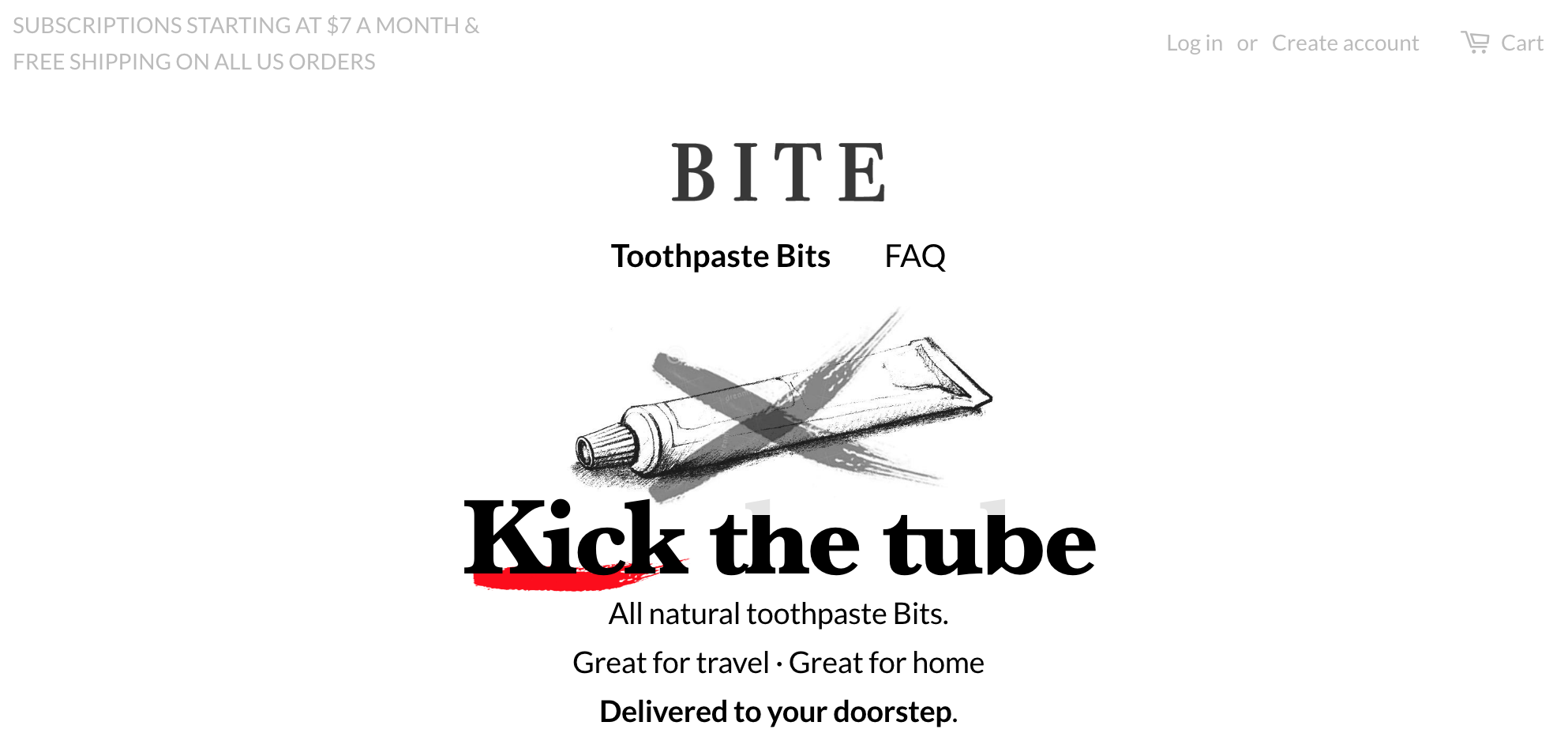
Usually, I never write about ecommerce businesses just starting out, because they rarely ever make it. But Lindsay has hustled so hard to make her first $1,000 that I had to share her story and the lessons I learned from talking with her so you can see what it really takes to build your own ecommerce business from scratch.
Here are the seven lessons I learned from Lindsay “Toothpaste Bits” McCormick that every ecommerce entrepreneur who wants to start their own physical product ecommerce business can follow:
1. Scratch Your Own Itch
Start by identifying problems you encounter in your day-to-day life that frustrate you. Lindsay was traveling all the time as a TV Producer for HGTV and found that she was going through travel toothpaste tubes at an alarming rate. These were little plastic bottles that Lindsay realized must take up a ton of landfill and can’t easily be recycled.

Lindsay looked for alternate solutions. She tried toothpaste powder and toothpaste tablets (from commercial brands and homemade products she found on Etsy), but both were still packaged in plastic that harms the environment. She also wanted to make it her mission to stop putting the tons of crap found in toothpaste into our bodies every day.
If you look at the back of a toothpaste tube, stuff like propylene glycol, sodium lauryl sulfate, and diethanolamine are all controversial ingredients that lots of people avoid. There is a ton of research and reasons why these chemicals shouldn’t be in our bodies. For example, Hydrated Silica is a commonly found chemical in toothpaste that even dentists agree is not always effective.[*]
Lindsay found that big toothpaste companies are getting away with using the cheapest and easiest (questionably) effective ingredients, even though there are safer and just as effective ingredients available. The thing is, those ingredients cost a little more, and you have to be okay with asking people to try something new (as in using either a powder or a tablet instead of a paste or gel.)
Lindsay says “commercial toothpaste is like fast food.” Fast food is cheap, chock full of weird preservatives and ingredients that may or may not be good for you but, yeah - it’s food. It will fill you up, and the FDA deems it safe, but just because it’s “safe” doesn’t mean you should eat it every single day.
Commercial toothpaste is the same. It has a bunch of questionable ingredients, it’s not sustainably made in any way, and sure, it cleans your teeth, but it’s not actually good for you. When Lindsay had all these realizations, she started researching her own organic non-paste toothpaste product which wouldn’t explode in her travel luggage like this:
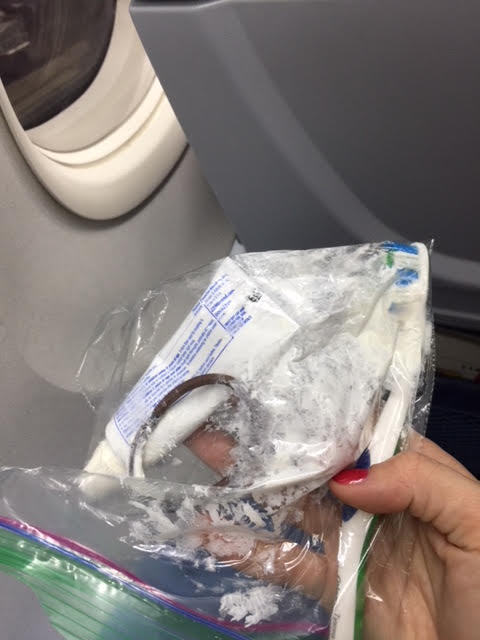
2. Research Your Product Idea
Lindsay had no idea how to make a toothpaste product, so she did three things:
- Watched cosmetic chemistry videos on YouTube
- Went on Reddit and found a post with a list of open source cosmetic chemistry classes she could take from MIT, University of Arizona and other universities
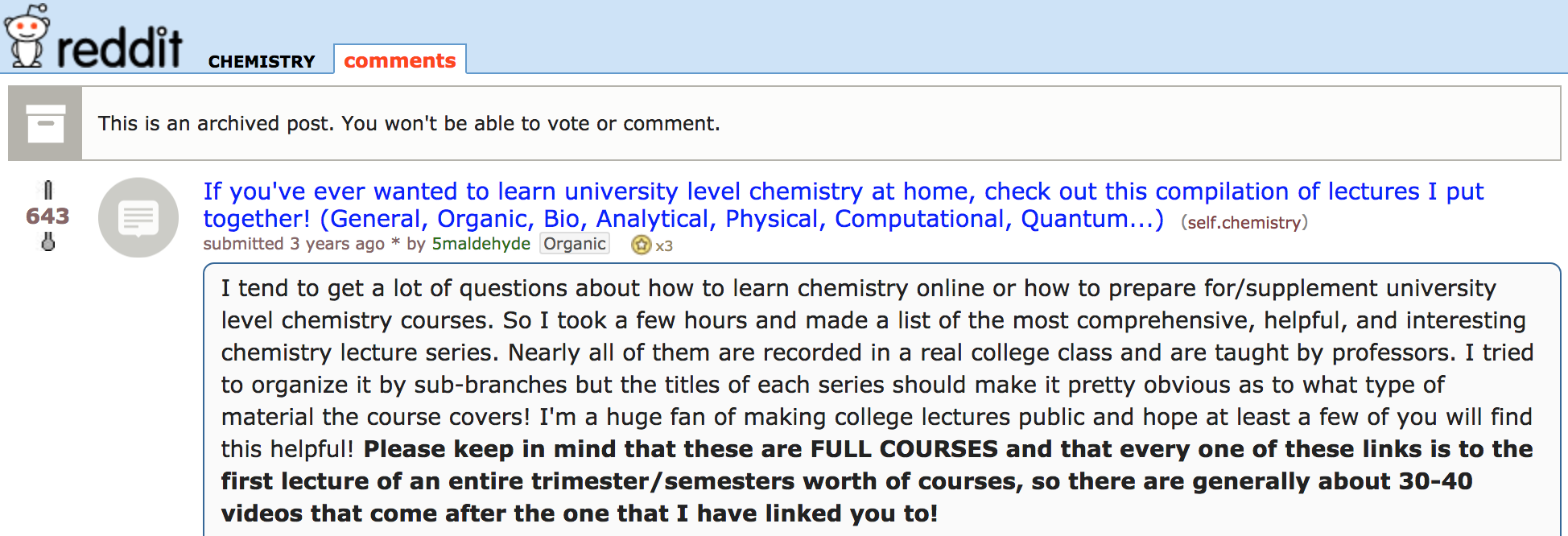
Lindsay couldn’t find full university courses to take for free, but she could find open source chemistry coursework and videos on this Reddit thread and YouTube from a variety of universities at no cost to her.
Went to the US Patent and Trademark Office (USPTO) to look up dental studies and patents to see what other people have done to find a solution. (Lindsay’s badge and research pictured below)

By going to the USPTO in person Lindsay, was able to meet with an off-duty examiner who helped explain the patent process. The patent database is super confusing to search if you don’t know what you are doing (Lindsay had no idea that missing a comma or where you place a word could totally change her search results), so she got help.
If you don’t live near the USPTO in Virginia, USA you can go to a USPTO satellite office in Dallas, Denver, Detroit, or San Jose to get help searching the database. Or you can call the USPTO office from the contact page on their website.
From this research, Lindsay discovered that most of the toothpaste tablets and powders on the market are baking soda-based. She found that toothpastes are made up mostly of water and abrasives, Hydrated Silica being the bad one (and also the most popular.) Hydrated Silica is harder than tooth enamel so by using it twice a day, every day you are literally slowly eroding your own enamel.[*]
Lindsay found that if you take the water out of the toothpaste, it becomes self-preserving (i.e., it doesn't require any synthetic preservatives to keep it fresh). She also found something called “Kaolin Clay” as a replacement ingredient for Hydrated Silica and two all-natural sugar alcohols (Xylitol and Erythritol) that protect by keeping bacteria from sticking to teeth.[*]
These three ingredients (when combined with the seven other hand-picked ingredients Lindsay researched) had the five properties she needed to make an all-natural toothpaste product suitable for oral consumption. These were:
- Tastes good
- Good for the environment
- Can bind to a solid toothpaste pill
- Are pressable
- Loose enough that they become powder when you put them in your mouth
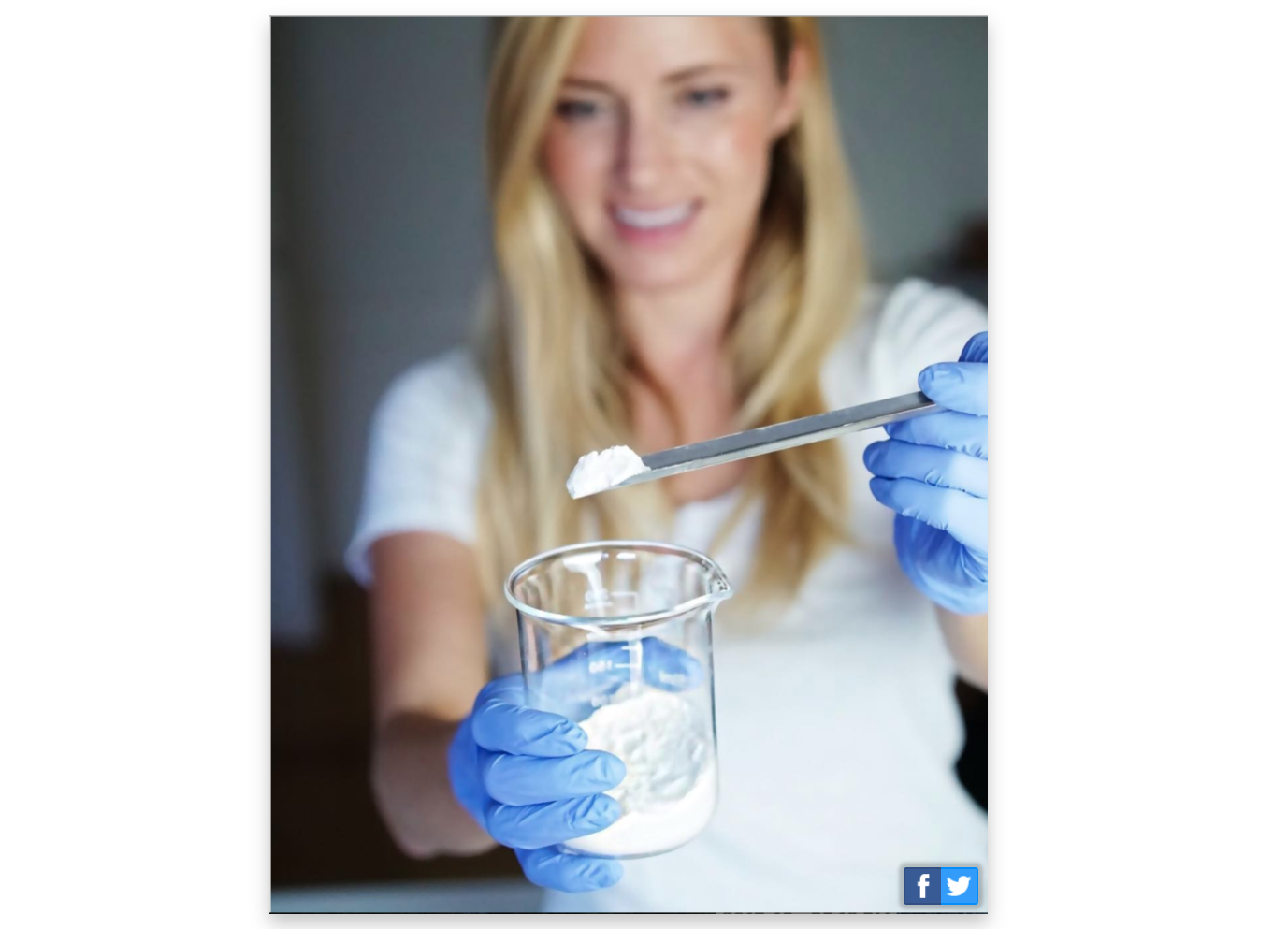
Lindsay’s solution: Toothpaste tablets made with organic plant-based ingredients clinically proven to clean and protect your teeth. Now she just had to find out how to make them herself.
3. Make Your Product
The first thing Lindsay did was search “how to make drugs.” Her thinking was: “people who make Ecstasy must know what to do.” And she was right. It was from this research that Lindsay bought a new TDP 0 tablet machine from China off eBay for $800. The machine took one month to arrive from China, but it arrived all rusted and corroded, so she had to ship it back and ask for a refund with pictures to prove it was used/old (even though the manufacturer said it wasn’t).
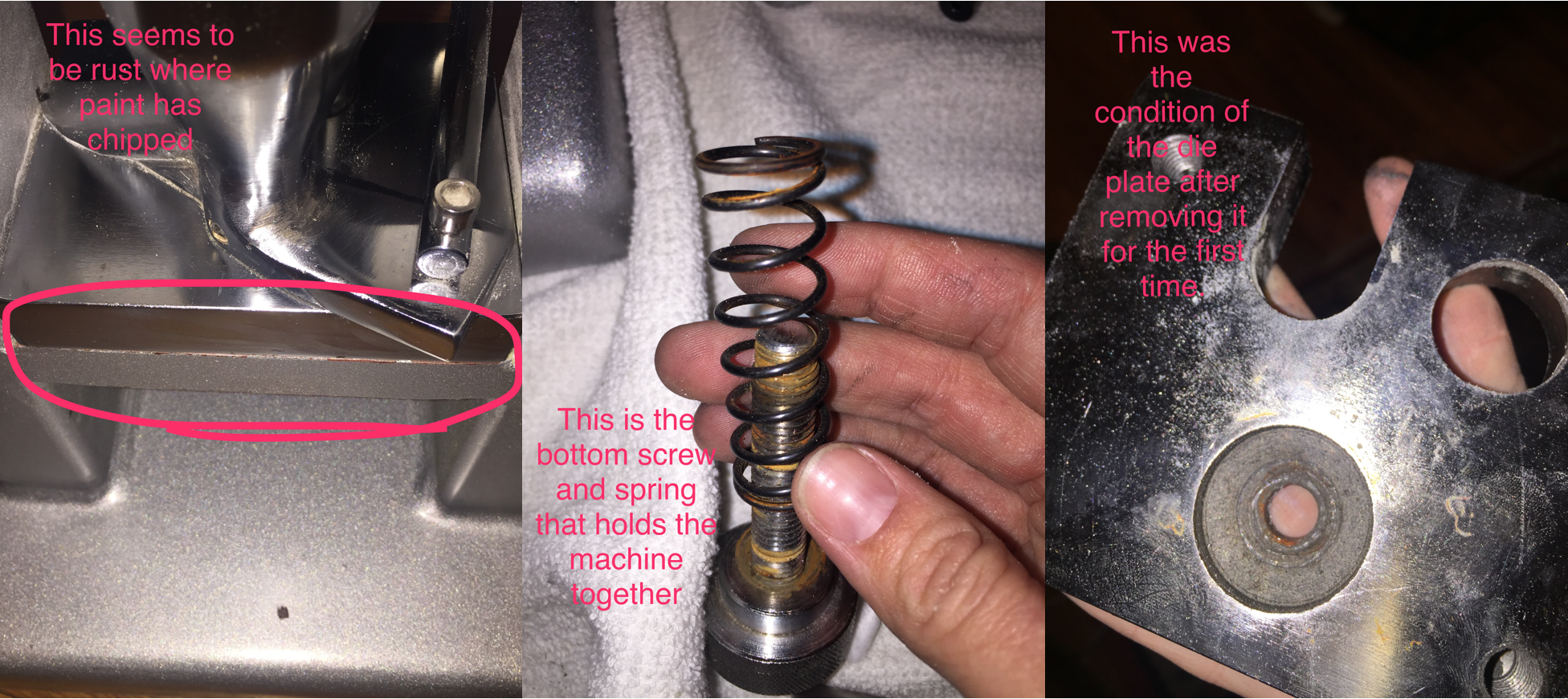
One month down the drain, Lindsay bought a new TDP 0 one-pill-at-a-time machine from Texas for $999. The TDP 0 machine in Texas was on backorder so in the meantime Lindsay flew to their offices in Texas to learn how to use the machine after realizing that they were not easy to use (after getting the previous machine from China).
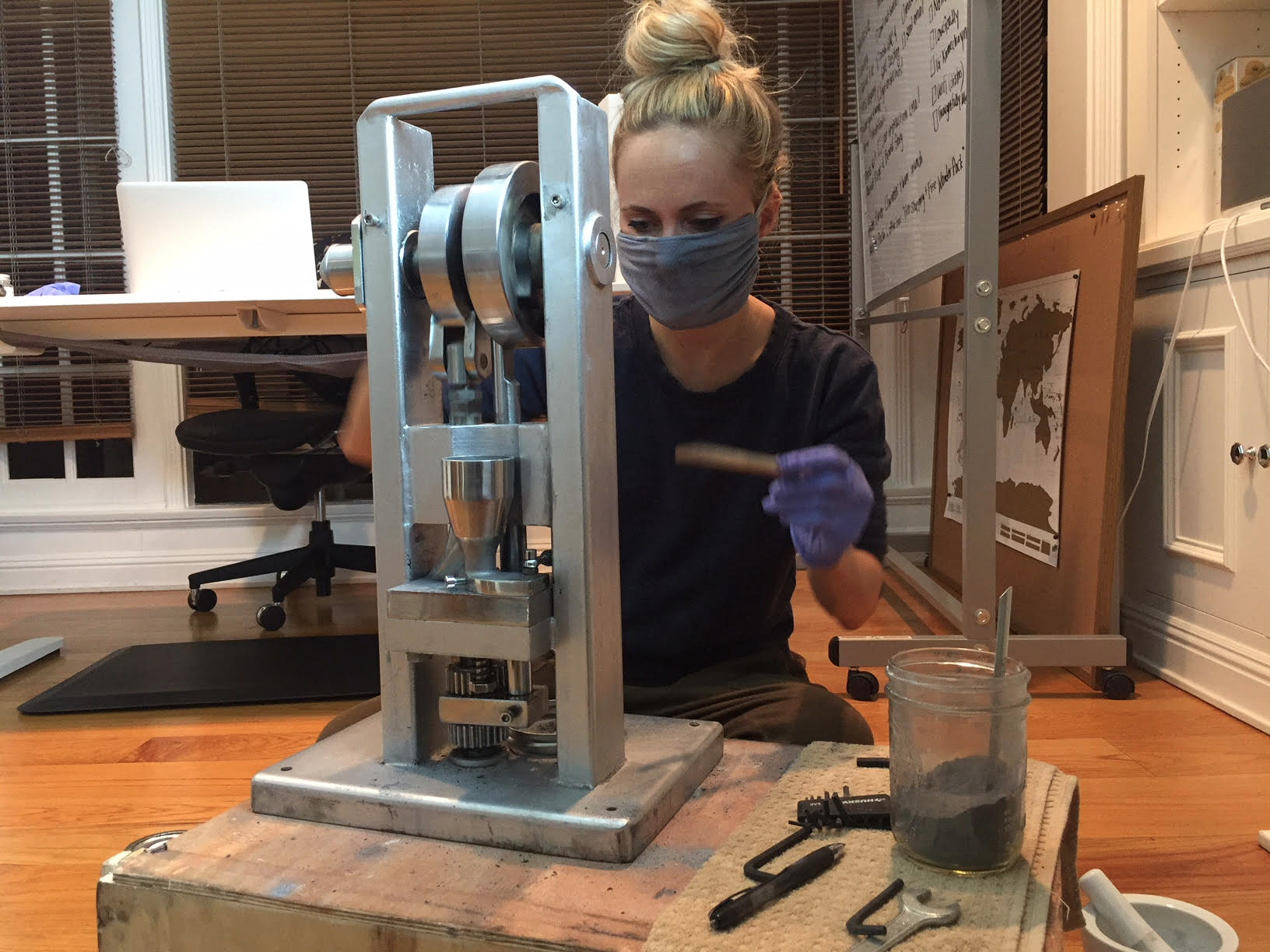
The machine arrived a few weeks later to Lindsay’s house in Los Angeles in perfect condition (pictured above). But it didn’t work out like she expected. The TDP 0 tablet machine she bought from Texas could only make one pill at a time, and it used a hand crank to do it. Lindsay thought her Mom would be her only customer for the first year because asking people to change a habit they do twice a day, every single day, is a big ask and she wasn’t sure how it was going to go.
Lindsay started getting orders from people other than her Mom and needed to make 90 pills per bottle, which was going to take forever with this one-pill-at-a-time machine. So she bought a TDP 5 machine from the same company in Texas for $2,599 that could make five thousand pills in an hour (pictured below).
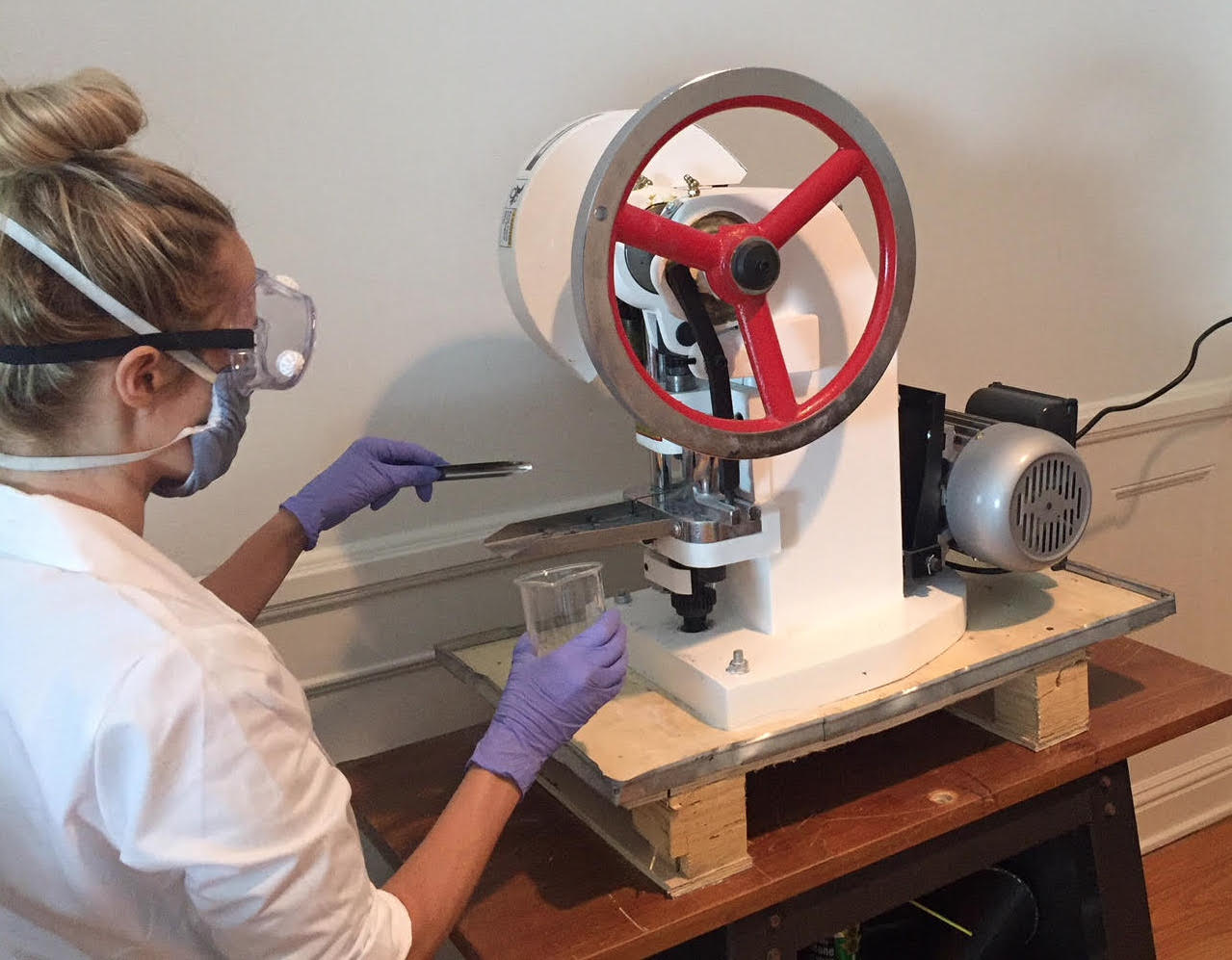
In total, Lindsay’s startup costs were about $6,000 after taking into account the following items:
- Two tablet machines (TDP 0 and TDP 5)
- Organic ingredients to make the toothpaste
- Table for the TDP 5 machine
- Accessories for the machines (grease gun, food-grade lubricant, dies, dust buster, glass beakers, scoopulas, glass pipettes, glass stirrers, metal trays, wrenches, Allen Key set)
- Uniform (gloves, coat, goggles, face mask)
- Packaging (glass bottles, caps, labels, stickers, anti-humidity packets, Kraft #000 envelopes, three custom rubber stamps, ink)
- Cleaning supplies (rubbing alcohol, stainless steel cleaner)
- Website tools (website domain, Shopify, Sumo)
- Business expenses (business registration, books, product photo props)
Toothpaste is considered a cosmetic unless it contains fluoride which makes it a drug, so Lindsay doesn’t require any certification. However she does follow the FDA cosmetic guidelines (including labeling laws, restricted ingredients, and state of production space.)[*]
And the first one-pill-at-a-time machine Lindsay bought hasn’t gone to waste. Lindsay now uses that as her “test” machine to test new flavor creations, and her TDP 5 for sales.
4. Promote Your Product
Lindsay’s website launched in August 2017, when she started taking sales for her new product: BITE Toothpaste Bits. But when she launched her site didn’t get a lot of traffic, so she bought Sumo #justkidding ;)
Here are the five things Lindsay did to make her first $1,000 in sales in three months:
- Told her Mom, family and close friends
- Made discount codes for her friends who had blogs (one vegan food blogger called Vegans Baby and two travel bloggers called Alex In Wonderland and Trusted Travel Girl). Each of these bloggers did an Instagram post for Lindsay’s product.
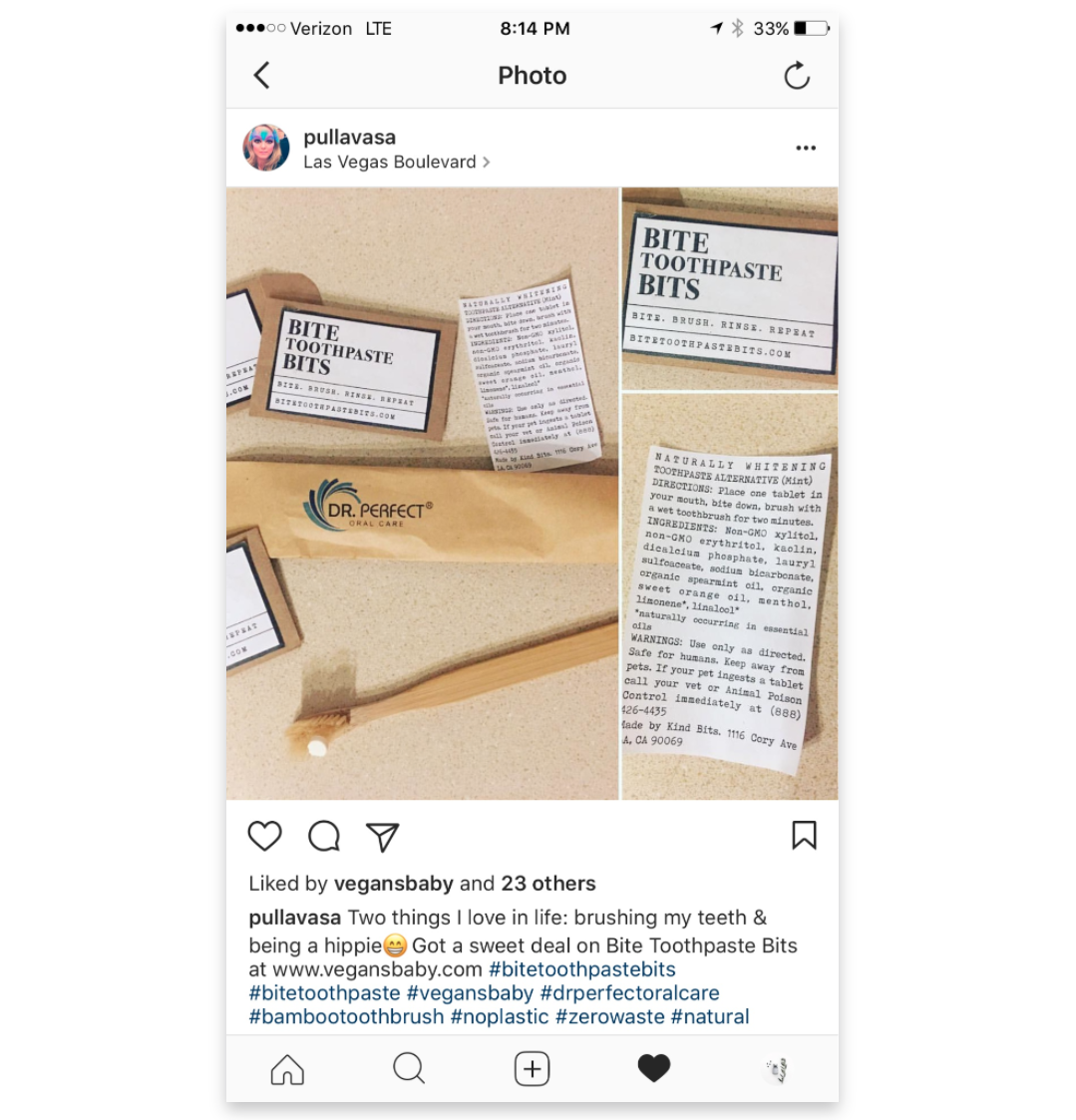
- Commented on conversations inside four different female entrepreneur Facebook Groups whenever a post about sustainable beauty would come up, and mention her product (this would usually generate at least one sale)
- Post about her product inside the Facebook Groups she joined when it was acceptable (e.g., one of the groups Lindsay’s in has a day called “Lady Brag Friday” where you can brag about anything you are up to)
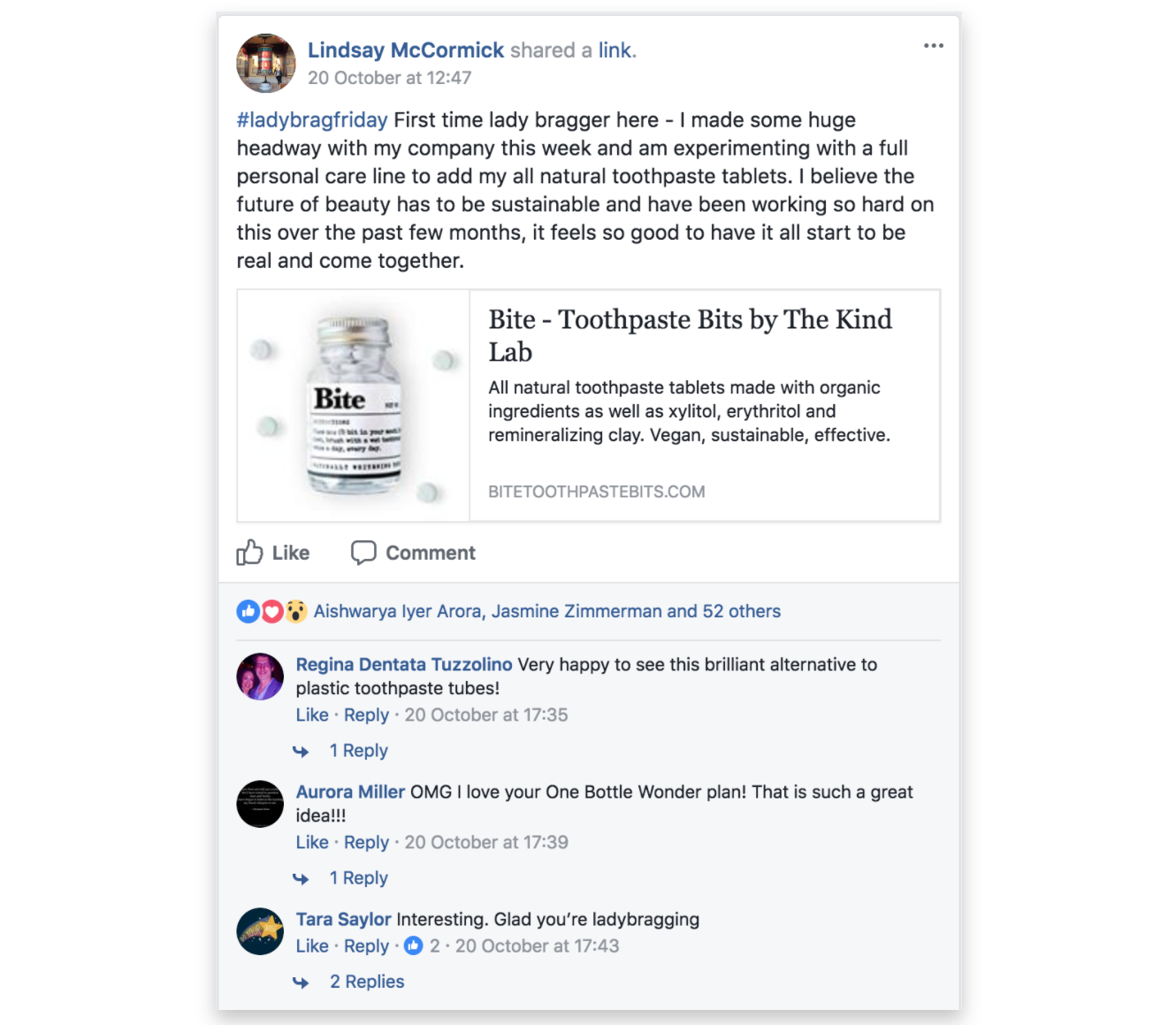
Ran a failed Facebook ad campaign for one week with $30 ad spend
Of all her promotion items, Facebook drove 90% of Lindsay’s traffic, which she tracked through Shopify. Based on this early Facebook success, Lindsay has plans to double down on Facebook, using advertising when she has the time to learn how to do it effectively.
5. Ship Your Product
As orders come in, Lindsay has found a process to fulfill them while still maintaining her 9-5 job. First, she automates order confirmation emails through Shopify.
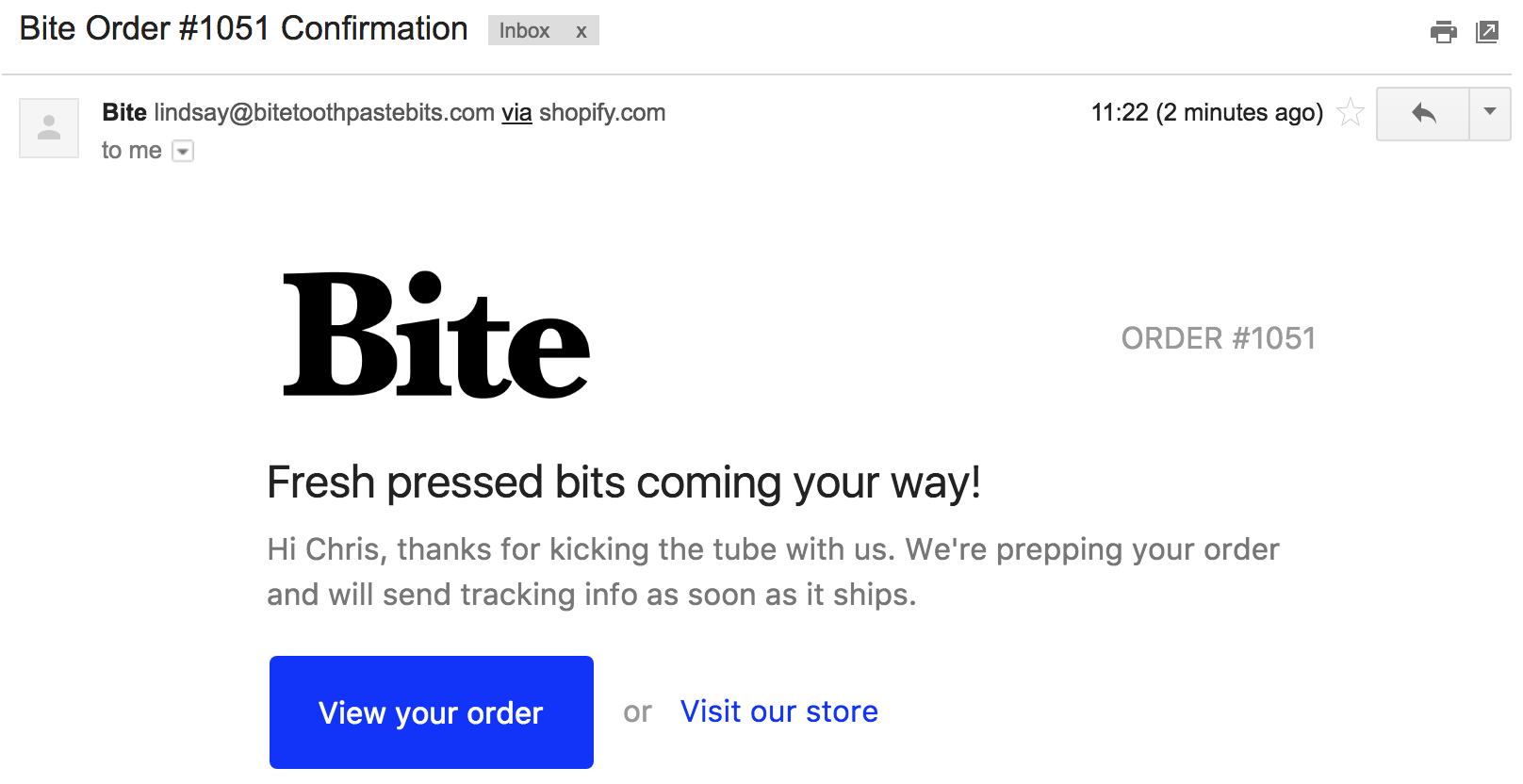
To fulfill existing orders, and prepare for future orders, she allocates Saturdays as her “Pill Pressing Day.” She’ll take that one day of the week to make pills, fill bottles and refill packs. She goes to the post office daily to ship orders as they come in. She uses Shopify to print her shipping barcodes and automate a personalized email once the barcode is scanned at the post office.
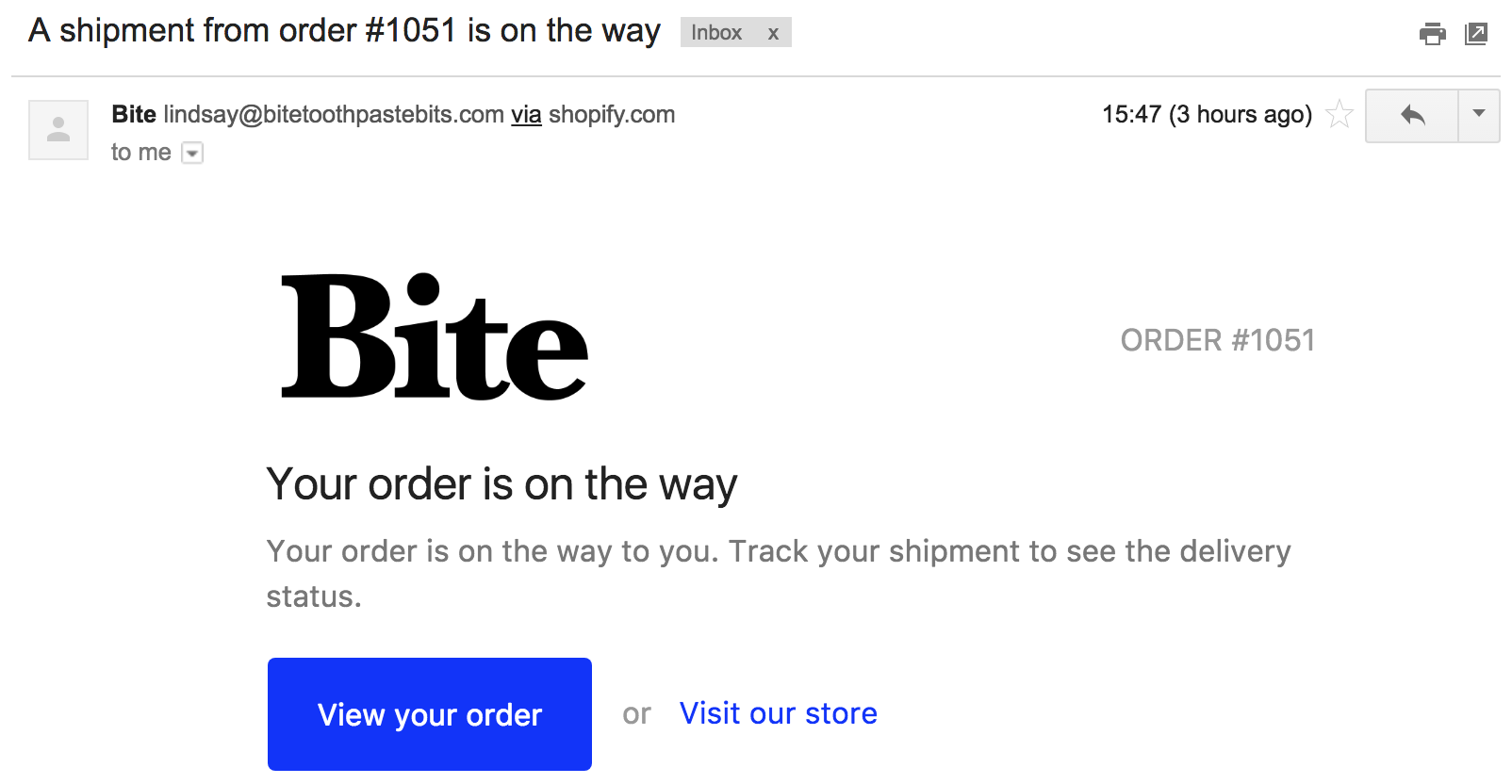
6. Grow Your Product
Right now Lindsay is focusing on changing people’s behavior by getting them to buy a single bottle of her product to test it and see how good it is compared to all the other sub-standard toothpaste products on the market. Long-term, however, Lindsay has a goal to primarily sell monthly subscriptions of her toothpaste bits bottles (available on her website under “The One Bottle Wonder” product).
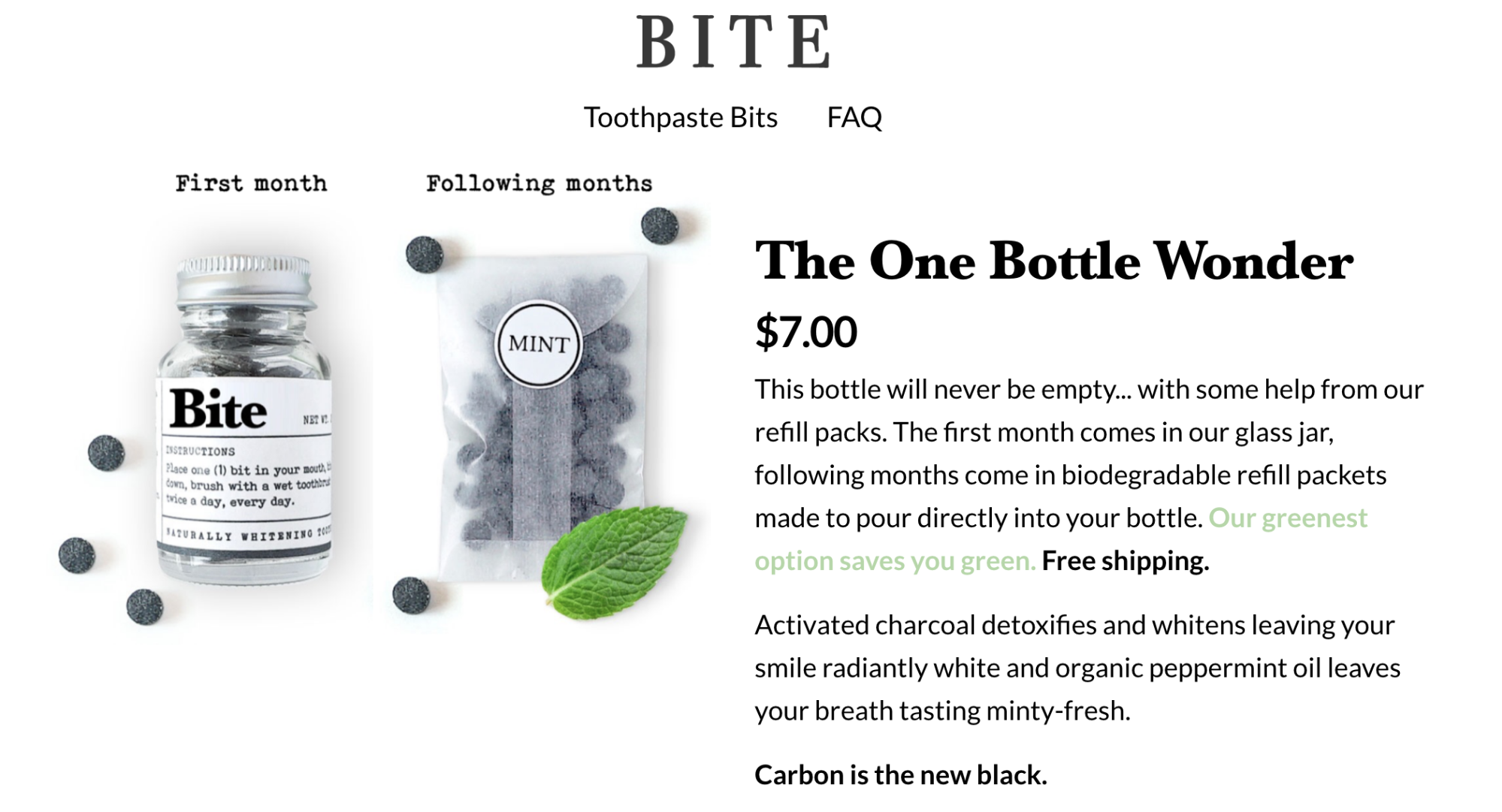
To be 100% transparent, Lindsay lists all of the ingredients she uses on her product pages (including the kaolin clay abrasive and two natural sugar alcohols she researched to find an all natural toothpaste alternative.)
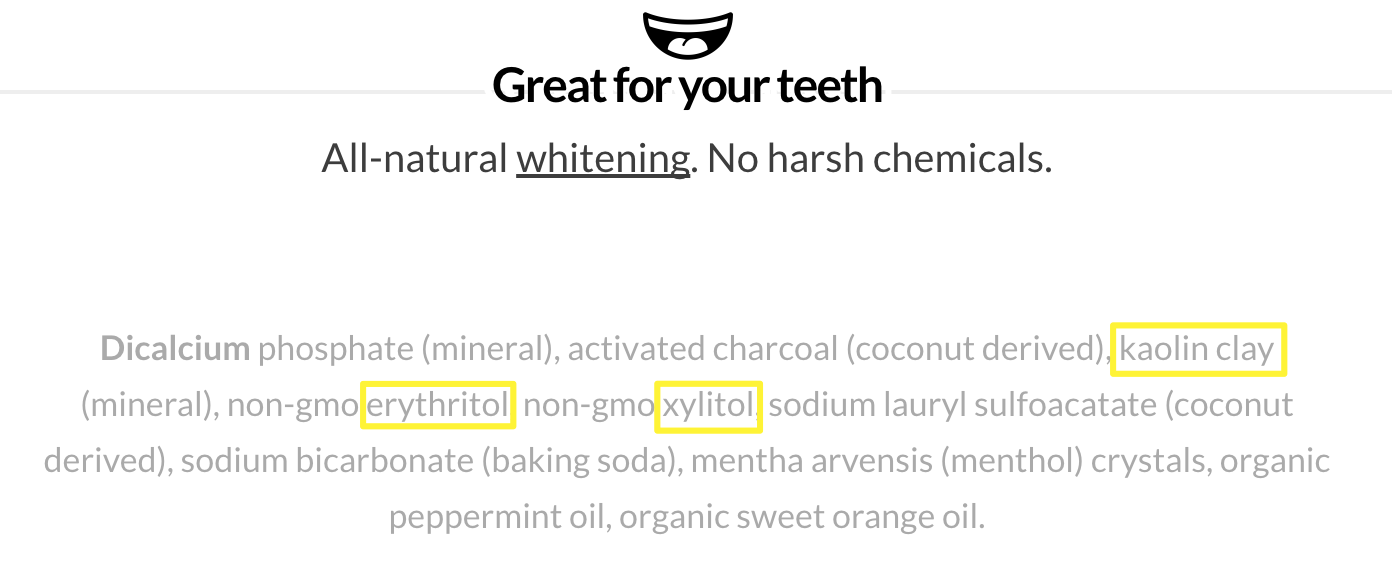
Moving forward, Lindsay would also like to sell her product wholesale to get more brand awareness and sales. She is also going to try and leverage her YouTube channel more for the promotion of her brand, with videos like this:
Lindsay has been vlogging for over two years on YouTube about her travel adventures and has built up over 17,000 subscribers. Her biggest regret is not building up an email list from her YouTube channel for this new product. In hindsight, Lindsay could have directed people back to her own website from her videos and used a Welcome Mat to capture email subscribers.
To grow her email list, Lindsay is now using Sumo.
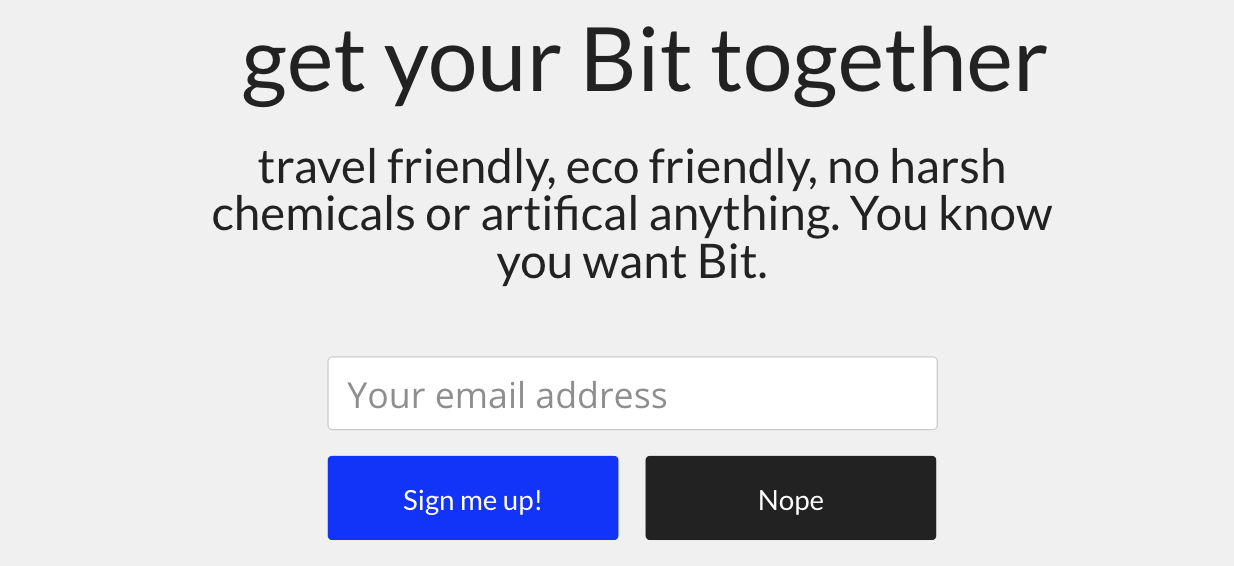
Lindsay’s website is built on Shopify. She found she was using lots of free Shopify plugins to try and do everything on her site, and she was being stretched thin across lots of different apps.
Lindsay likes using Sumo because it’s a hub for everything a small business owner needs to grow to the next-level (email capture, a/b testing, content upgrades, analytics, etc.), and it replaces many external Shopify plugins.
Since making her first $1,000 and installing Sumo on her website, Lindsay is now sending a weekly newsletter of her new flavors and tips to her email subscribers and customers.

Here are the initial results from Lindsay’s newsletter where she sent a “Fall Flavor” and “Fall Coffee Tips” email to her new email list. Since generating only 39 email subscribers, Lindsay is already making sales:


7. Have A Purpose
Of all the lessons I learned from Lindsay, this is the most important. Without a purpose, she wouldn’t be able to work a full-time job from 9am-6pm and then work on her ecommerce business from 7pm-3am.
Lindsay has made it her life’s purpose to:
- Reduce chemicals in our bodies, and
- Reduce plastic in our landfills
It’s the whole reason she started the business in the first place. Lindsay packages all her products in recyclable glass jars and uses certified organic ingredients to make her toothpaste bits.
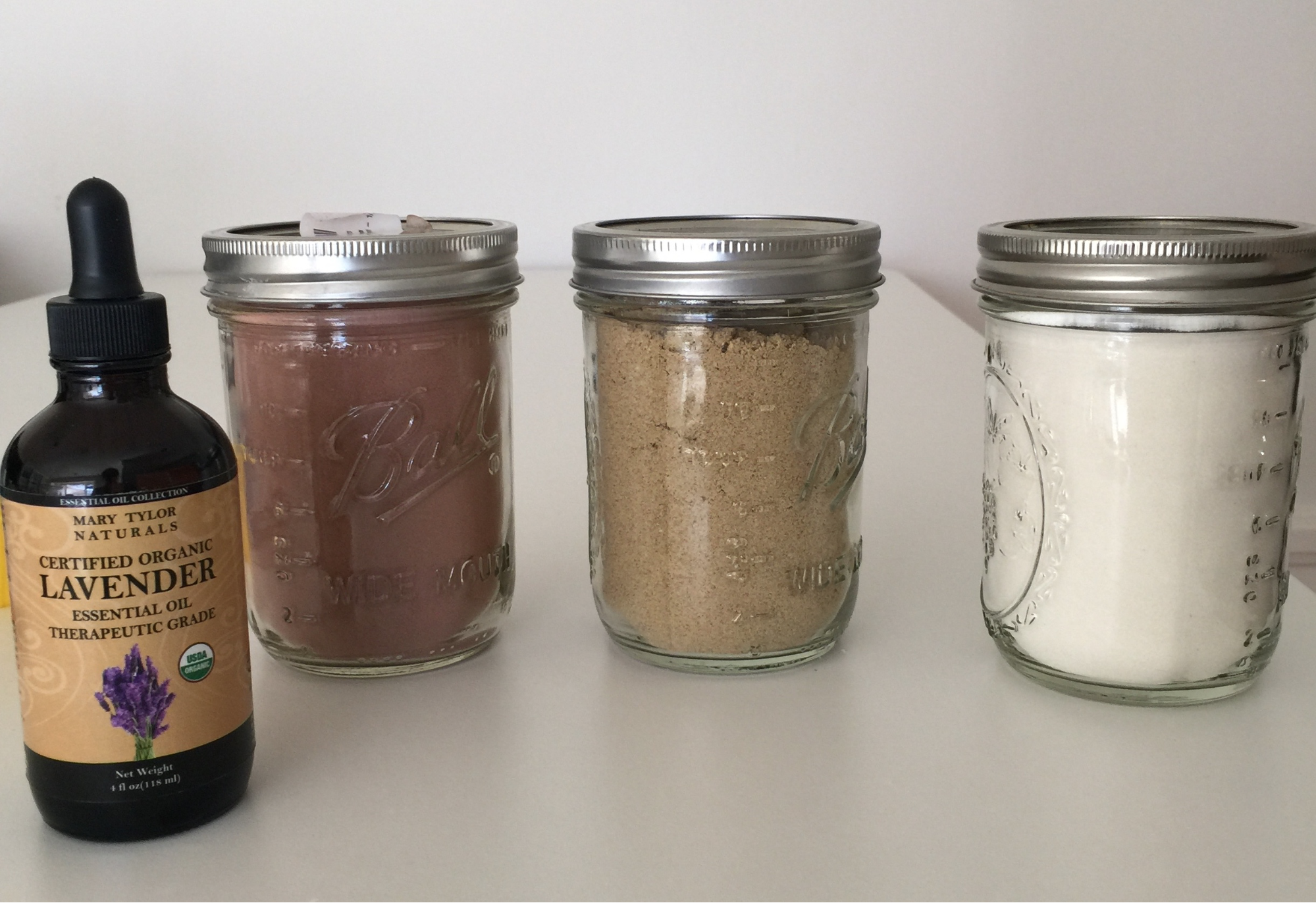
Before you start your ecommerce business, take Lindsay’s advice: “Don’t look for a product you think will sell; find or make a product you believe needs to exist. Find something that feels bigger than you and go all in.”
Lindsay would have happily given up after her third all-nighter pressing tablets or her second time smashing her finger in her machine if she hadn’t been motivated by her “mission” to kick the tube, put fewer chemicals into our bodies, and put less plastic into our landfills.
You can kick the tube, brush without chemicals, and help Lindsay make her next $1,000 by buying a bottle of Bite Toothpaste Bits here.
Or if you want to work out how much it might cost to start your own ecommerce business like Lindsay, grab our Ecommerce Startup Cost Calculator below.


Comments